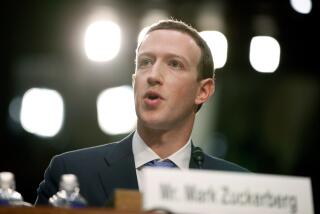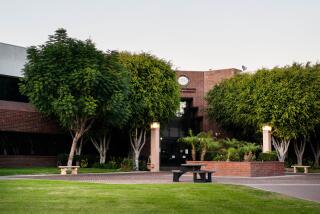Gates Foundation to Give $1 Billion for Scholarships
- Share via
The $1-billion gift pledged by Microsoft Corp. Chairman Bill Gates on Thursday for a scholarship fund is one of the most ambitious private efforts in history to boost prospects for minorities in technical fields, where they are severely underrepresented.
The fund, from the Bill and Melinda Gates Foundation, will underwrite 20,000 scholarships over 20 years and offers a rejoinder to critics who have accused Gates, the world’s wealthiest individual, of being slow to share his vast personal fortune, valued at some $100 billion.
For the record:
12:00 a.m. Sept. 18, 1999 For the Record
Los Angeles Times Saturday September 18, 1999 Home Edition Part A Page 3 National Desk 1 inches; 35 words Type of Material: Correction
Philanthropists--A Thursday story about Microsoft Chairman Bill Gates’ $1-billion scholarship fund described Charles Feeney as the second-greatest philanthropist of all time. Feeney is actually the second-greatest living philanthropist.
The monetary commitment is only matched in U.S. history by media mogul Ted Turner’s $1-billion 10-year grant to the United Nations.
“The biggest barrier to minority educational attainment is not family values. It’s not grades. It’s money,” said William H. Gray III, chief executive of the United Negro College Fund. With this grant, he said, “that barrier, the biggest barrier, is eliminated.”
Gray’s agency will administer the $50-million annual Gates Millennium Scholars Program, which will support students from the undergraduate through doctorate level in science, engineering, mathematics, education and library sciences.
In many technical fields, only 1% to 2% of doctoral degrees go to African Americans, Latinos and other minority students, according to Gray.
“You are talking about a program that will double or triple those numbers over the next two decades,” Gray said.
The scholarships come at a time when college is increasingly viewed as a necessity for personal advancement.
Twenty-five percent of the U.S. population holds bachelor’s degrees. The closest competitor is the Netherlands, at 22%.
But the progress has not benefited all groups equally: Twenty-eight percent of white Americans between ages 25 and 29 held bachelor’s degrees in 1996, according to the American Council on Education. The rate for African Americans was 15% and for Latinos, 10%. And that graduation gap is widening, according to Morton Schapiro, an economics professor at USC who studies education issues.
Sara Martinez Tucker, chief executive of the National Hispanic Scholarship Fund, said that she expects the multiyear nature of the Gates gift to make a substantial difference in her group’s ability to raise the graduation rate of Latinos to 18% by 2006.
“This is the first time we are going to be able to say to kids, whatever the unmet need, we will cover it as long as you keep up your academic standing,” Tucker said.
Among all groups, family income is heavily correlated with college participation: Statistically, the poorer you are, the least likely you are to get a college degree.
Meanwhile, measures to eliminate affirmative-action programs have reduced the ability of some public universities to award scholarships based on race, said Terry Lightfoot, spokesman for the University of California.
“When you talk to young people, one of the basic reasons for their either slowing down, or stepping out of school for a while, it’s always financial need,” said Piedad Robertson, president of Santa Monica College and a representative on the advisory council charged with overseeing the scholarship process. “The dream is to free them from that financial worry so they can be the best they can as scholars.”
The scholarship program will support up to 4,000 students a year, beginning in fall 2000.
High school seniors, college students, as well as college graduates going on to advanced training in the targeted fields will be eligible in the first year of the program, after which only high school seniors will be considered.
High school candidates for the scholarship must be U.S. citizens with at least a 3.3 grade point average who show evidence of significant financial need and a history of leadership in their communities.
Educational experts welcomed the Gates effort, though some offered caveats.
Joni Finney, vice president of the National Center for Public Policy and Higher Education, doubts that the scholarships will increase minority participation in college.
Because the scholarships are based on academic merit, they will target “those young people planning on going to college anyway,” Finney said.
Bringing more minorities into the college system who would otherwise lose out would require offering aid to average B and C students--who tend to be disproportionately low-income, she said.
The Gates Foundation recently became the nation’s largest philanthropic entity with assets exceeding $17 billion. Since its inception in 1994, it has given some $322 million to support public-health efforts, particularly those fighting AIDS, and working to improve the distribution of vaccinations in the developing world.
The foundation also has given or pledged some $301 million to support the use of the Internet and computer technology in America’s schools and libraries.
Despite the commitment of such large sums, the foundation’s long-term directions--like its founder’s own priorities for influencing society beyond the worlds of business and technology--have been far from clear.
The scholarship program suggests that Gates will place a high priority on tackling the problems of the “digital divide.” That growing gap separates technology sophisticates and those who cannot afford or do not understand how computers can improve their economic prospects.
“Every minority you encourage to get involved in these [technical] areas and make it easier for them as they get through college, they’ll become a leader,” Gates said.
Trevor Neilson, a Gates Foundation spokesman, said the foundation will strongly emphasize improving opportunities for minorities and that grants on the order of $50 million will soon seem routine. Gates has repeatedly stated that he will ultimately give away the vast majority of his personal wealth.
As a practical matter, federal law governing charitable giving requires the Gates Foundation to give away about 5% of its asset base annually--in this case, some $850 million.
Although characterized as a $1-billion bequest, the impact of interest over 20 years makes the actual value of the gift $573.5 million, assuming the contributions would earn 6% annually.
Some critics have suggested that Gates’ generosity toward libraries may have been motivated by a desire to continue the dominance of his Windows operating system, the software most library computers use. Others believe that his recent philanthropic activities may have been designed partly to counter his public-image problems associated with Microsoft’s dominance of the software industry and the pending Department of Justice antitrust lawsuit against the company.
But this latest effort, and the inevitable increase in his foundation’s grants over the coming years, may silence some doubters.
“People will always quibble over the percentage of his income that he has given to charity, but the total dollars are far above any other donor,” said Stacy Palmer, editor of the Washington-based Chronicle of Philanthropy. Next to Gates, the single greatest philanthropist of all time is Charles Feeney, who made a fortune on duty-free shops and has given away some $4 billion, she said.
*
Charles Piller reported from San Francisco, and Jill Leovy reported from Los Angeles.
More to Read
Sign up for Essential California
The most important California stories and recommendations in your inbox every morning.
You may occasionally receive promotional content from the Los Angeles Times.













